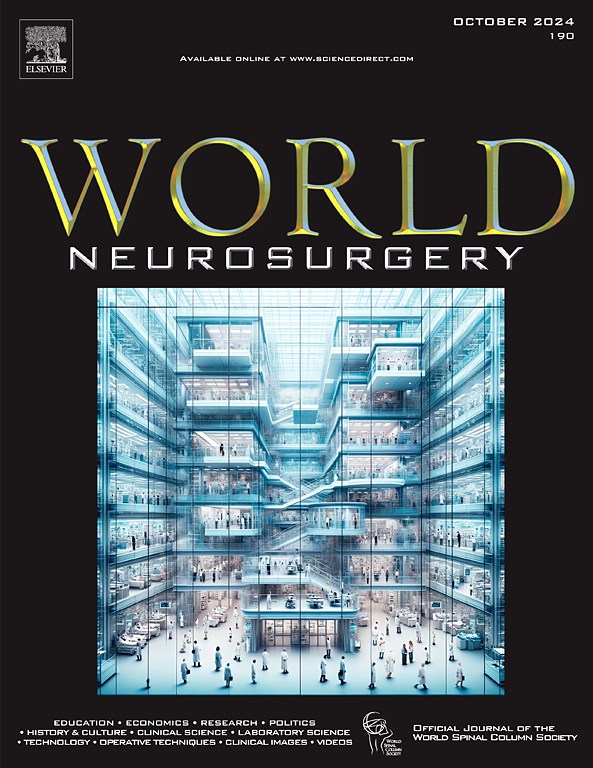Brainstem Cavernous Malformations: A Systematic Review and Meta-Analysis
IF 2.1
4区 医学
Q3 CLINICAL NEUROLOGY
引用次数: 0
Abstract
Background
Brainstem cavernous malformations (BSCMs) are rare yet high-risk vascular lesions with a complex clinical course due to their eloquent location. Optimal treatment remains a topic of debate. This review aims to evaluate the outcomes of different management strategies for BSCMs, with a focus on rebleeding, functional recovery, and mortality.
Methods
Following Preferred Reporting Items for Systematic Reviews and Meta-Analyses guidelines, databases, including PubMed and Scopus, were searched. Data from 45 studies were analyzed using crude and pooled estimates. We used meta-regression to predict outcomes and adjust for heterogeneity. The risk of bias was assessed using the Risk Of Bias In Non-randomized Studies of Interventions -I and Risk Of Bias In Non-randomized Studies of Interventions-II tools.
Results
This meta-analysis included 45 studies with 3070 patients: 1928 underwent surgery, 543 radiosurgeries, and 599 conservative treatments. Surgery had the lowest recurrence (1.1%), rebleeding (3.3%), retreatment (1.3%), and mortality (1.4%) rates. Radiosurgery showed moderate rates (recurrence 4.4%, rebleeding 7.0%, and retreatment 4.1%), while conservative management had the highest rebleeding (26.3%) and mortality (3.2%). Functional improvement (modified Rankin Scale [mRS]) was highest in the surgical group (60.2%) versus radiosurgery (28.3%) and conservative care (35.7%). Larger lesion size significantly predicted worse mRS improvement (P = 0.007) and higher mortality (P = 0.02), especially in radiosurgical patients.
Conclusions
Our findings largely reflect the cohort of hemorrhagic or symptomatic BSCMs for which microsurgical resection is generally associated with more favorable outcomes, including lower rates of recurrence, rebleeding, and mortality, when compared with radiosurgery and conservative care. Caution is warranted in extrapolating to incidental or asymptomatic lesions. Future research should also integrate advanced imaging and molecular approaches to refine risk stratification and guide management.
脑干海绵状血管瘤:系统回顾和荟萃分析。
背景:脑干海绵状血管瘤(BSCMs)是一种罕见但高风险的血管病变,由于其良好的位置,其临床过程复杂。最佳治疗仍然是一个有争议的话题。本综述旨在评估BSCMs不同治疗策略的结果,重点关注再出血、功能恢复和死亡率。方法:按照PRISMA指南,检索PubMed、Scopus等数据库。来自45项研究的数据使用粗略估计和汇总估计进行了分析。我们使用元回归来预测结果并调整异质性。使用ROBINS-I和ROBINS-II工具评估偏倚风险。结果:本荟萃分析包括45项研究,3070例患者:1928例接受手术,543例接受放射手术,599例接受保守治疗。手术的复发率(1.1%)、再出血(3.3%)、再治疗(1.3%)和死亡率(1.4%)最低。放射外科治疗的复发率中等(4.4%,再出血7.0%,再治疗4.1%),而保守治疗的再出血率最高(26.3%),死亡率最高(3.2%)。功能改善(mRS)在手术组中最高(60.2%),而放射手术组(28.3%)和保守治疗组(35.7%)。病变面积越大,mRS改善越差(p = 0.007),死亡率越高(p = 0.02),尤其是放射外科患者。结论:我们的研究结果在很大程度上反映了出血性或有症状的BSCMs队列,与放射手术和保守治疗相比,显微手术切除通常与更有利的结果相关,包括更低的复发率、再出血率和死亡率。在推断偶发或无症状病变时应谨慎。未来的研究还应结合先进的影像学和分子方法来完善风险分层和指导管理。
本文章由计算机程序翻译,如有差异,请以英文原文为准。
求助全文
约1分钟内获得全文
求助全文
来源期刊

World neurosurgery
CLINICAL NEUROLOGY-SURGERY
CiteScore
3.90
自引率
15.00%
发文量
1765
审稿时长
47 days
期刊介绍:
World Neurosurgery has an open access mirror journal World Neurosurgery: X, sharing the same aims and scope, editorial team, submission system and rigorous peer review.
The journal''s mission is to:
-To provide a first-class international forum and a 2-way conduit for dialogue that is relevant to neurosurgeons and providers who care for neurosurgery patients. The categories of the exchanged information include clinical and basic science, as well as global information that provide social, political, educational, economic, cultural or societal insights and knowledge that are of significance and relevance to worldwide neurosurgery patient care.
-To act as a primary intellectual catalyst for the stimulation of creativity, the creation of new knowledge, and the enhancement of quality neurosurgical care worldwide.
-To provide a forum for communication that enriches the lives of all neurosurgeons and their colleagues; and, in so doing, enriches the lives of their patients.
Topics to be addressed in World Neurosurgery include: EDUCATION, ECONOMICS, RESEARCH, POLITICS, HISTORY, CULTURE, CLINICAL SCIENCE, LABORATORY SCIENCE, TECHNOLOGY, OPERATIVE TECHNIQUES, CLINICAL IMAGES, VIDEOS
 求助内容:
求助内容: 应助结果提醒方式:
应助结果提醒方式:


